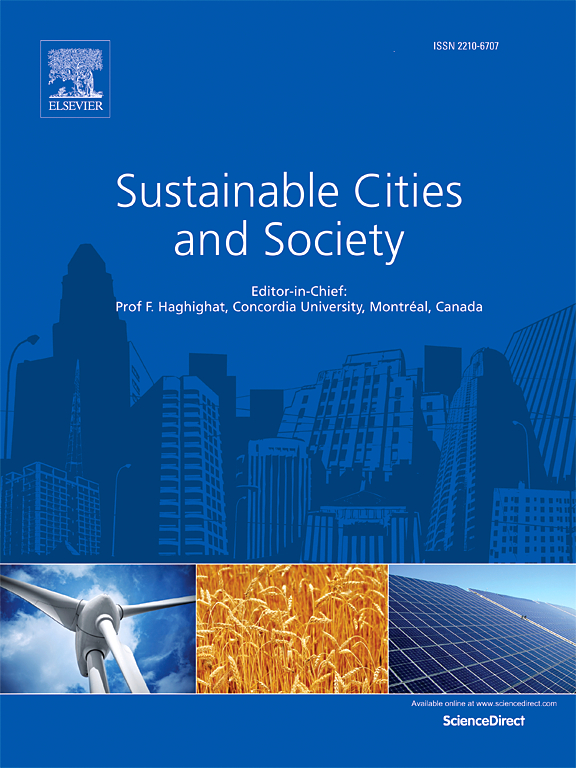Enhancing flood resilience of urban rail transit systems through recovery resource scheduling optimisation: A case study of London
IF 10.5
1区 工程技术
Q1 CONSTRUCTION & BUILDING TECHNOLOGY
引用次数: 0
Abstract
As heavy rainfall increasingly disrupts services of urban rail transit systems (URTSs), enhancing their resilience to flood risks is crucial to sustaining reliable public transport, particularly amid growing climate challenges. To investigate the effectiveness of potential interventions for mitigating post-flood impacts on URTS operations, this research introduces a novel application of genetic algorithms to optimise recovery resource scheduling for URTSs following large-scale flood-induced disruptions. The objective is to reduce economic impacts related to revenue loss and operational impacts concerning disruptions to passenger travel. By systematically integrating network topology, operational performance, flood disruption scenarios, and recovery profiles, the methodology is demonstrated through the London URTS under 30-year, 100-year, and 1,000-year flood risk scenarios. Compared to a topological attribute-determined benchmark, the optimised resource scheduling solutions have a tangible effect in reducing post-flood impacts. In the London case study, revenue loss can be reduced by 10.9%, 10.7%, and 6.7% across the respective flood scenarios, corresponding to savings of approximately £337K, £708K, and £760K, along with decreased unmet travel demand of 197K, 404K and 470K. These results demonstrate the significance of strategic resource scheduling in ensuring effective recovery from large-scale flood disruptions, offering valuable insights for disaster risk management, especially for extreme weather scenarios.
通过恢复资源调度优化提高城市轨道交通系统的抗洪能力:以伦敦为例
随着暴雨日益干扰城市轨道交通系统的服务,增强其抵御洪水风险的能力对于维持可靠的公共交通至关重要,尤其是在气候挑战日益严峻的情况下。为了研究减轻洪水后对URTS运行影响的潜在干预措施的有效性,本研究引入了遗传算法的新应用,以优化大规模洪水引起的URTS中断后的恢复资源调度。目标是减少与收入损失有关的经济影响和与客运中断有关的业务影响。通过系统地整合网络拓扑、操作性能、洪水破坏情景和恢复概况,该方法通过伦敦URTS在30年、100年和1000年洪水风险情景下进行了演示。与拓扑属性确定基准相比,优化后的资源调度解决方案在减少灾后影响方面具有切实的效果。在伦敦的案例研究中,在各自的洪水情景下,收入损失可以减少10.9%,10.7%和6.7%,相当于节省约33.7万英镑,708万英镑和76万英镑,同时减少了19.7万英镑,404万英镑和47万英镑的未满足旅行需求。这些结果证明了战略性资源调度在确保大规模洪水中断后有效恢复方面的重要性,为灾害风险管理提供了宝贵的见解,特别是在极端天气情况下。
本文章由计算机程序翻译,如有差异,请以英文原文为准。
求助全文
约1分钟内获得全文
求助全文
来源期刊

Sustainable Cities and Society
Social Sciences-Geography, Planning and Development
CiteScore
22.00
自引率
13.70%
发文量
810
审稿时长
27 days
期刊介绍:
Sustainable Cities and Society (SCS) is an international journal that focuses on fundamental and applied research to promote environmentally sustainable and socially resilient cities. The journal welcomes cross-cutting, multi-disciplinary research in various areas, including:
1. Smart cities and resilient environments;
2. Alternative/clean energy sources, energy distribution, distributed energy generation, and energy demand reduction/management;
3. Monitoring and improving air quality in built environment and cities (e.g., healthy built environment and air quality management);
4. Energy efficient, low/zero carbon, and green buildings/communities;
5. Climate change mitigation and adaptation in urban environments;
6. Green infrastructure and BMPs;
7. Environmental Footprint accounting and management;
8. Urban agriculture and forestry;
9. ICT, smart grid and intelligent infrastructure;
10. Urban design/planning, regulations, legislation, certification, economics, and policy;
11. Social aspects, impacts and resiliency of cities;
12. Behavior monitoring, analysis and change within urban communities;
13. Health monitoring and improvement;
14. Nexus issues related to sustainable cities and societies;
15. Smart city governance;
16. Decision Support Systems for trade-off and uncertainty analysis for improved management of cities and society;
17. Big data, machine learning, and artificial intelligence applications and case studies;
18. Critical infrastructure protection, including security, privacy, forensics, and reliability issues of cyber-physical systems.
19. Water footprint reduction and urban water distribution, harvesting, treatment, reuse and management;
20. Waste reduction and recycling;
21. Wastewater collection, treatment and recycling;
22. Smart, clean and healthy transportation systems and infrastructure;
 求助内容:
求助内容: 应助结果提醒方式:
应助结果提醒方式:


